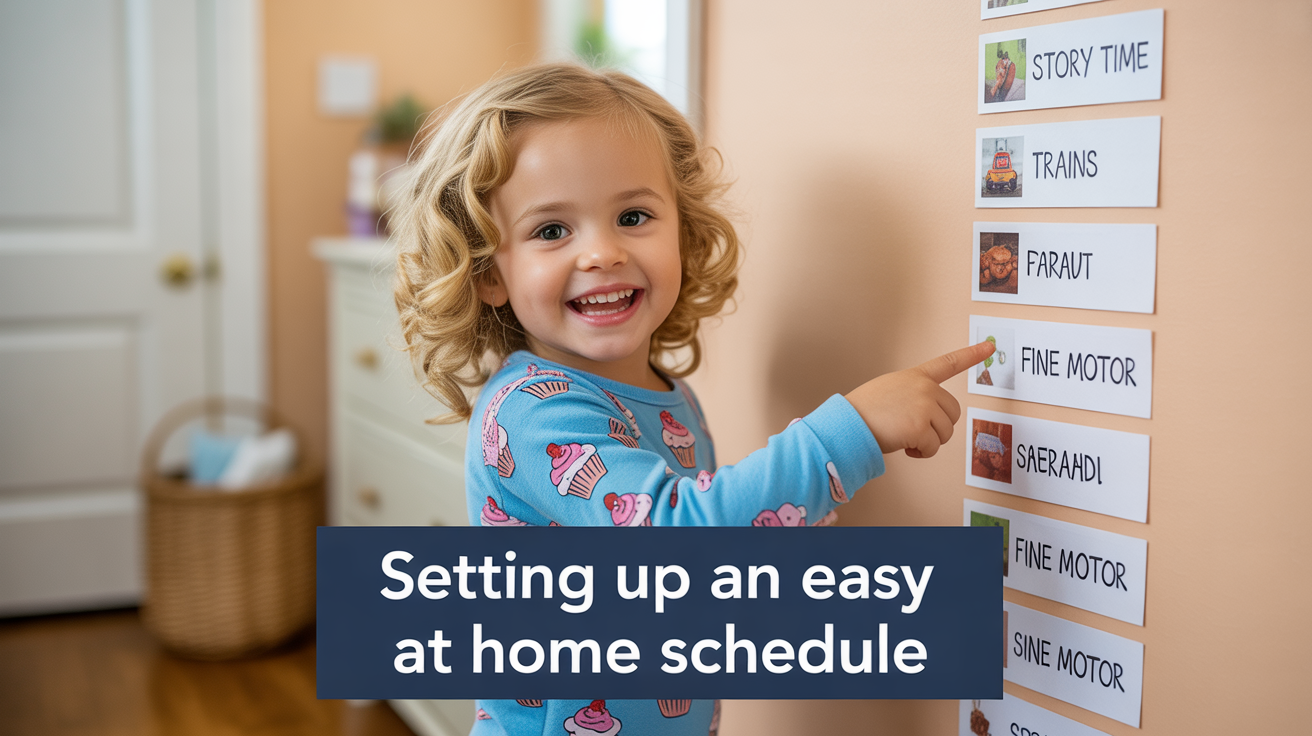6 Steps to Build a Homeschooling Schedule That Works
In the dynamic world of homeschooling, the dream of flexible, personalized education can sometimes feel more like a juggling act. Days can swing between focused learning and unexpected diversions, leaving even the most dedicated parents wondering how to find equilibrium. If you’ve ever felt overwhelmed by the quest for structure amidst the beautiful chaos of family life, you’re not alone.
The secret to transforming this challenge into a triumph lies in mastering one crucial element: the best homeschooling schedule. This isn’t just about timetables; it’s about crafting a rhythm that nurtures academic growth, sparks curiosity, and preserves the precious moments of family connection. Get ready to discover how a well-designed schedule can bring harmony and effectiveness to your homeschooling journey.
For those just embarking on this educational adventure, understanding the initial steps is crucial. Learn more about How to Start Homeschooling to lay a strong foundation for your journey.
Key Takeaways
Why a Homeschooling Schedule is Crucial for Success
A clear homeschool schedule significantly reduces stress for both parents and children. It takes away the daily guesswork, creating a predictable rhythm where everyone knows what to expect, which in turn brings a sense of security and calm. This predictability allows parents to focus on teaching, while kids can dive deeper into their studies, free from uncertainty.
Secondly, putting a homeschooling schedule into practice directly leads to improved learning outcomes. By setting aside consistent time slots for main subjects, extra activities, and even free play, you make sure all important areas get covered. This organized approach prevents things from being overlooked, builds basic skills, and helps children develop essential time management skills.
Finally, a well-designed homeschool schedule creates a positive learning environment. It sets clear boundaries between study time and free time, preventing burnout and making learning feel purposeful. When children know that free time is built into their day, they’re often more motivated to concentrate, leading to a rich and engaging educational experience.
Ultimately, a smart homeschooling schedule is a powerful tool for a more peaceful, productive, and successful homeschooling adventure.
The 3 Golden Rules of a Successful Homeschooling Schedule

While the idea of a homeschooling might conjure images of rigid timetables and strict adherence, the most effective schedules are built upon a foundation of three golden rules:
It Must Be Flexible: Embrace the Rhythm, Not the Clock
The most important rule for any homeschooling schedule is its flexibility. Unlike traditional schools, homeschooling thrives on being able to adapt. Many new homeschoolers try to copy a public school timetable, which often leads to frustration. Life happens: a sick child, a sudden field trip, or a deep dive into an interesting topic can easily disrupt rigid plans.
Instead, think of a rhythm or flow for your day. Have a general order, but leave plenty of room for changes. If a spontaneous nature walk comes up, move math to the afternoon. This flexibility is key for staying sane and creating a positive learning space, especially for a homeschooling schedule for beginners. It shows that true learning isn’t always stuck in specific time slots.
f you’re new to the concept, delving into our comprehensive guide on How to Start Homeschooling can provide invaluable insights.
It Must Be Family-Centered: Your Unique Blueprint
The second key rule for your homeschooling schedule is to make it all about your family. It needs to fit your unique needs, interests, and daily flow, not some perfect idea from outside. Every family is different: some wake early, others stay up late; some have kids of all ages with different learning styles; some parents work from home. Trying a “one-size-fits-all” schedule just won’t work.
Think about when your kids are most awake and ready to learn. Maybe mornings are best for core subjects, or perhaps a later start suits your family better. Factor in activities, meals, and quiet time. The goal is to create the best homeschooling schedule that blends smoothly with your family life, making it feel natural and sustainable for everyone.
It Should Teach Responsibility: Empowering Young Learners
The final key for a great homeschooling schedule is teaching responsibility and letting your kids own their learning. This means setting up the day to encourage self-management, not constant micromanaging. If parents handle every detail, kids might miss out on developing vital motivation and organization skills.
Get your children involved in making the schedule. Even little ones can help pick the order of activities. As they grow, they can take on more responsibility for their own tasks and time. Using checklists or visual schedules helps them track progress.
This approach not only eases your workload but also builds important skills, leading to a genuine love for learning and preparing them for more independence. Beyond academic skills, homeschooling offers a unique opportunity to instill vital life skills. Consider how a well-structured schedule can also contribute to teaching practical responsibility, such as learning How to Raise a Financially Responsible Child.
How to Plan a Homeschool Schedule: A Step-by-Step Guide
Now that we understand the foundational principles, let’s dive into the practicalities of how to plan a homeschool schedule that is both effective and sustainable.
First, consider your educational priorities, keeping in mind any requirements from the Homeschooling Laws by State that pertain to your family. . If subjects like math and science are key, your schedule will naturally dedicate more time there. If arts and music are your passion, those creative pursuits will take center stage. Your schedule is your chance to emphasize what you value most.
Next, think about learning styles. Every child learns differently – some love hands-on activities, others prefer reading. A truly effective schedule makes room for these individual preferences.
Finally, factor in your family dynamics: parent work schedules, sibling activities, and daily routines. This thoughtful approach leads to a realistic and manageable plan, ensuring everyone’s needs are met for a balanced homeschooling experience.
Part of assessing your needs often involves selecting the right educational materials. To guide you through this crucial decision, explore our detailed review of the Top 10 Best Homeschool Curriculum & How to Choose.
Short-Term Goals: These might include daily or weekly objectives, such as completing a specific chapter in a science textbook, finishing a writing assignment, or dedicating 30 minutes to reading aloud each day. For younger children, it could be mastering a particular letter sound or counting to 20.
Long-Term Goals: These are broader objectives that might span a semester or an entire academic year. Examples include completing a full year of a specific curriculum, developing strong research skills, or fostering a deeper understanding of a historical period. For high schoolers, it might involve preparing for standardized tests or building a portfolio for college applications.
Regularly reviewing these goals will help you adjust your homeschooling schedule as needed and ensure that your daily activities are aligned with your broader educational vision.
Start your day with a morning routine. This is your chance to connect, review yesterday’s wins, chat about today’s plans, or even kick things off with a dose of motivation.
Tackle core subjects like math and reading in the morning when minds are fresh and focused. Then, spread out other subjects, giving each one the time it deserves for balanced learning.
Remember to weave in breaks and physical activity. Short pauses between lessons and a longer lunch break keep energy high and prevent grumpiness. Think yoga, stretching, or some outdoor fun!
Save afternoon activities for electives, hands-on projects, or extracurriculars – anything from art and music to science experiments or sports. These add variety and excitement to the day.
Finally, wrap up with an end-of-day review. Talk about what your child learned, tackle any questions, and set the stage for tomorrow’s adventures. This consistent rhythm makes homeschooling smoother and more effective for everyone. When establishing your homeschooling routine, a key decision involves the overall educational approach and materials you’ll use. For insights into selecting the most suitable resources, review our guide on the Top 10 Best Homeschool Curriculum & How to Choose.
Build in buffer time for unexpected delays or spontaneous adventures; it’ll ease stress and keep you on track. Consider weekly planning rather than daily, allowing you to adapt to changes more easily as the week unfolds.
Most importantly, keep open communication with your kids. Involve them in the planning process and listen to their input. This collaborative approach ensures your schedule truly works for everyone, making your homeschooling journey smoother and more enjoyable.
Think of online tools as powerful allies. Integrate computer-based lessons and videos to complement traditional teaching, offering extra explanations and practice. Educational apps can turn learning into fun with quizzes and games, boosting your child’s enthusiasm.
Don’t forget virtual field trips! Explore museums or historical sites from your living room, broadening your child’s horizons and making education an adventure. These digital aids can make your homeschooling journey more dynamic and effective.
Regularly review your schedule. Ask yourself:
Are we completing activities?
Are the kids engaged, or are they burning out?
Is there enough flexibility for the unexpected?
Are we hitting our goals?
Is it boosting our family dynamic?
Don’t be afraid to try new things with time blocks or subject rotations. The aim is continuous improvement, always striving for the best homeschooling schedule that truly supports your family’s unique journey.
Sample Homeschooling Schedules for Every Grade Level
A well-crafted sample homeschool schedule isn’t just about managing time; it’s your secret weapon for efficient study and a proper learning framework. Let’s explore a typical homeschooling day, from morning to night, starting with kindergarten!
Kindergarten to Grade 2: Nurturing Curiosity Through Play
For our youngest learners, the kindergarten homeschool schedule should prioritize short, engaging activities, abundant play, and joyful exploration to spark a lifelong love for learning. Keep lessons brief and incorporate movement and sensory experiences.
| Time | Activity | Focus |
|---|---|---|
| 7:30 AM – 8:30 AM | Rise & Shine | Morning routine, exercise, breakfast, fine motor skills |
| 8:30 AM – 9:00 AM | Morning Circle | Songs, calendar, weather |
| 9:00 AM – 10:00 AM | Literacy Adventures | Phonics, reading skills |
| 10:00 AM – 10:30 AM | Snack & Play Break | Recharge and fun |
| 10:30 AM – 11:30 AM | Math Explorations | Counting, basic operations |
| 11:30 AM – 12:00 PM | Creative Corner | Drawing, painting, imaginative play |
| 12:00 PM – 1:00 PM | Lunch & Chill | Nourishment and rest |
| 1:00 PM – 2:00 PM | Story & Chat | Reading aloud, discussion |
| 2:00 PM – 3:00 PM | Outdoor Play | Gross motor skills, fresh air |
| 3:00 PM – 4:00 PM | Quiet Discovery | Puzzles, independent reading |
| 4:00 PM – 6:00 PM | Family Connections | Shared conversation, quality time |
| 6:00 PM – 7:00 PM | Dinner Together | Mealtime, table manners |
| 7:00 PM – 8:00 PM | Wind Down | Fresh up, bedtime routine |
Grades 3 to 5: Building Independence and Deeper Learning
As children grow, the schedule for this age group can offer more structured academic blocks, fostering independent study while keeping room for their unique interests and hands-on learning.
| Time | Activity | Focus/Details |
|---|---|---|
| 7:00 AM – 8:00 AM | Morning Routine & Breakfast | Get ready for the day, fuel up. |
| 8:00 AM – 9:00 AM | Language Arts | Grammar, writing assignments, reading comprehension from a chapter book. |
| 9:00 AM – 10:00 AM | Mathematics | Dedicated time for lessons, practice problems, problem-solving. |
| 10:00 AM – 10:30 AM | Snack & Active Break | Quick snack, move around, play outside, short physical activity. |
| 10:30 AM – 11:30 AM | Science or History/Social Studies | Alternating days for readings, discussions, and projects. |
| 11:30 AM – 12:30 PM | Electives/Independent Projects | Art, music, coding, research, foreign language – child-led learning. |
| 12:30 PM – 1:30 PM | Lunch & Free Time | Recharge and relax. |
| 1:30 PM – 2:30 PM | Reading Aloud/Independent Reading | Continue family read-aloud or dedicated time for independent reading. |
| 2:30 PM – 3:30 PM | Physical Education/Outdoor Activity | Sports, bike riding, nature exploration, structured exercise. |
| 3:30 PM onwards | Chores, Extracurriculars, Family Time | Transition to after-school activities, family responsibilities, and leisure. |
Middle School (Grades 6-8): Fostering Autonomy and Critical Thinking
Here’s a sample daily flow for a middle school homeschooling schedule, designed to foster independence and deeper learning:
| Time | Activity | Focus/Details |
|---|---|---|
| 6:30 AM – 7:30 AM | Morning Routine & Breakfast | Get ready for the day and fuel up. |
| 7:30 AM – 8:30 AM | Mathematics | Advanced concepts, problem-solving, independent practice. |
| 8:30 AM – 9:30 AM | Language Arts | In-depth literature analysis, structured essay writing, advanced grammar. |
| 9:30 AM – 10:00 AM | Break | Time to stretch and recharge. |
| 10:00 AM – 11:00 AM | Science | Biology, Chemistry, Physics introductions, experiments, research. |
| 11:00 AM – 12:00 PM | History/Social Studies | Engage with primary sources, discussions, project-based learning. |
| 12:00 PM – 1:00 PM | Lunch | Break for a meal. |
| 1:00 PM – 2:00 PM | Foreign Language/Elective | Dedicated time for language acquisition or chosen electives (coding, art). |
| 2:00 PM – 3:00 PM | Physical Activity/Outdoor Time | Stay active and enjoy the outdoors. |
| 3:00 PM – 4:00 PM | Independent Study/Project Work | Research, complete assignments, work on long-term projects. |
| 4:00 PM onwards | Chores, Extracurriculars, Leisure | Transition to family responsibilities, outside activities, and free time. |
High School (Grades 9-12): Preparing for the Future
For high school, homeschooling schedules become more specialized, focusing on independent learning, advanced coursework, and managing a demanding academic load, much like a college schedule. It’s all about preparing students for higher education or vocational training.
Here’s a sample daily flow for a high school homeschooling schedule:
| Time | Activity | Focus/Details |
|---|---|---|
| 6:00 AM – 7:00 AM | Morning Routine & Breakfast | Start the day and fuel up. |
| 7:00 AM – 8:00 AM | Mathematics | Algebra, Geometry, Calculus, or other advanced math concepts. |
| 8:00 AM – 9:00 AM | Language Arts | Advanced Literature, Composition, Research Papers. |
| 9:00 AM – 10:00 AM | Science | Physics, Chemistry, Biology, or AP-level science courses. |
| 10:00 AM – 10:30 AM | Break | Time to recharge. |
| 10:30 AM – 11:30 AM | Social Studies | World History, US History, Government, Economics. |
| 11:30 AM – 12:30 PM | Elective/Vocational Subject | Advanced art, music theory, computer science, or a vocational skill. |
| 12:30 PM – 1:30 PM | Lunch | Break for a meal. |
| 1:30 PM – 2:30 PM | Foreign Language/Advanced Placement (AP) Study | Dedicated time for language acquisition or intensive AP course prep. |
| 2:30 PM – 3:30 PM | Physical Education/Independent Exercise | Stay active and healthy. |
| 3:30 PM – 5:00 PM | Independent Study/Homework/Project Work | Crucial time for deep work, research, and completing complex assignments. |
| 5:00 PM onwards | Extracurriculars, Family Time, Leisure | Transition to outside activities, family responsibilities, and free time. |
The Homeschool Loop Schedule: A Flexible Alternative
If rigid timetables don’t fit your family, a homeschool loop schedule offers flexibility. Instead of fixed times, you rotate through subjects or activities from a list. This ensures everything gets covered regularly, removing the pressure of daily deadlines and adapting to your family’s unique flow.
How a Loop Schedule Works?
Imagine a flexible homeschooling schedule where you have a list of subjects like art, history, or science that don’t need daily attention. Instead of fixed times, you create a “loop.” When you finish one subject, you simply move to the next on your list, no matter the day.
For example, your loop might be: Art, Music, History, Science. If you complete Art and Music on Monday, but Tuesday is busy, you just pick up with History on Wednesday. There’s no “falling behind,” only continuous progress through your learning cycle. This method is perfect for subjects benefiting from longer, less frequent sessions or for families who love a relaxed, child-led approach.
Benefits of Using a Loop Schedule
A homeschool loop schedule offers immense benefits. It provides increased flexibility, easily adapting to life’s interruptions and reducing stress for both parents and children. This method ensures all subjects are covered eventually, preventing anything from being consistently overlooked.
It also accommodates varying interests, allowing deeper dives into engaging topics. Plus, it’s ideal for multi-age homeschooling, simplifying planning for diverse learners.
Considerations for Loop Schedules
While flexible, a homeschool loop schedule works best when core subjects like Math have daily slots. Consistency is still key; decide how often you’ll cycle through the loop. Ensure resources are ready for smooth transitions, and parental involvement is vital for tracking progress. This approach balances freedom with accountability for a harmonious homeschooling journey.
Tips and Tricks for a Successful Homeschooling Schedule
Crafting a great homeschooling schedule is an art. Here are key techniques to make yours effective and stress-free:
- Use a Planner: Whether digital or physical, a planner helps you visualize your week, track progress, and jot down notes. It’s essential for staying organized and can work wonders with a homeschool loop schedule for added flexibility.
- Involve Your Children: Letting kids participate in schedule planning boosts their ownership and responsibility. Even young children can help choose activities, while older ones can manage their own goals and deadlines, teaching vital life skills.
- Don’t Overschedule: A common mistake for homeschooling schedule for beginners is packing too much in. Leave room for buffer time, unscheduled play, and field trips. Overscheduling leads to burnout; flexibility is key for a love of learning. For a complete roadmap on launching your homeschooling experience effectively, be sure to read How to Start Homeschooling.
- Prioritize Self-Care: Homeschooling is demanding. Schedule downtime and self-care for yourself – quiet time, exercise, social connections. A well-rested parent better guides their children. Ensure kids also get ample unstructured time for processing and play.
- Be Ready for Adjustments: Expect interruptions. Instead of failures, see them as chances to practice flexibility. Have backup plans and be willing to pivot. Adaptability is crucial for successful homeschooling.
- Utilize Resources & Community: Tap into online communities, local co-ops, educational apps, and libraries. These resources lighten your load, offer new perspectives, and ensure your homeschooling schedule is as effective and enjoyable as possible.
Conclusion
Creating the best homeschooling schedule is about building a flexible, family-centered framework that reduces stress and boosts learning. Embrace adaptability, involve your children, and don’t overschedule. Remember, your schedule is a living guide, evolving with your family. By thoughtfully refining it, you’ll cultivate a joyful learning environment where curiosity thrives and independence grows.
Resources:




